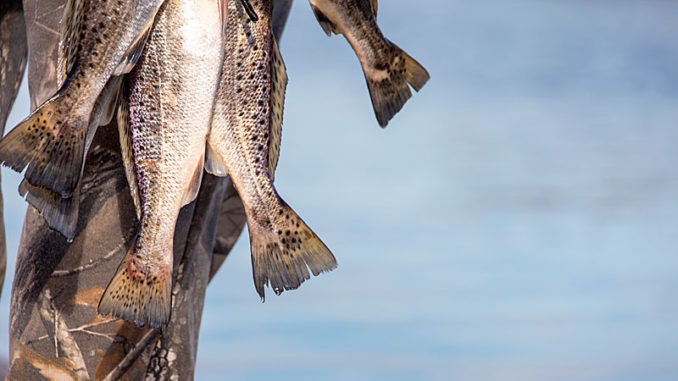
This speckled trout thing had to come sometime.
You know the thing — the proposed decrease in daily limits and the increase in minimum size limits for Louisiana.
Like my dearly departed swampateer buddy Alcide once said, “An lemme tole you one ting ma fren, dis ting ain jus one ting, it’s a whole buncha tings.”
The funny ting — ok, we’ll get off that — the peculiar thing is that all this hurrah about lowering the daily limit to 15 — it’s now 25 — and pushing the minimum “keeper” size to 13.5 inches — it’s 12 now — comes during maybe the best speckled trout catching seasons in at least five years. Go figure.
Dats not, oops, that’s not to say our trout population isn’t in trouble.
It is, and because lots more fishermen are having trouble catching speckled trout, it’s spurred our Wildlife and Fisheries biologists into a more aggressive population study.
So, three years and some months ago, the survey said “overfished and undergoing overfishing.”
And, like my Theodore Roosevelt Conservation Partnership son, Chris, said, those are “…(fishery) management terms. A more accurate description is “depleted.” And there are lots more more factors involved in this problem than fishermen taking fish from the water.”
Looking back 30 years
It’s at this point in this discussion I need to take you back more than 30 years ago when our state’s redfish stock was in peril. The culinary craze for blackened redfish put lots of pressure on a fish some among us considered to be inferior table fare. Trout Almondine was the premier offering at high-end restaurants.
So, the first limit, albeit a very liberal one — a daily limit was 50 trout and redfish in the aggregate – redfish became a “cause celebre,” and it didn’t take long after that for the daily limit to be reduced to today’s five with minimum size limit and an additional limit of only one measuring more than 27 inches.
During all those redfish discussions in our State Legislature, marine biologist Dr. Richard Condry offered a cautionary note to his testimony about restoring our redfish population.
Condry said it might not matter what we do with limits, and recruitment of young fish into the population, and escapement of larger fish into the breeding stock, but we should be concerned about the deterioration of our marshes.
Our marshes
In essence, Condry said our disappearing marshes will not be able to support the marine life we knew then, because our marshes were losing “its edge effect,” and it’s in those “edges” where our abundant marine life grows from larvae to juveniles to adults both for predators and their forage.
What Condry said was the interplay between freshwater and saltwater — the brackish marshes — is what more than validates Louisiana’s claim of “The Sportsman’s Paradise.”
And when those redfish numbers rebounded, fishing folks far and wide put Louisiana on their bucket list when it came to catching redfish. We had them and lots of other places didn’t. Plain and simple.
Same’s true for speckled trout. When the other four Gulf States were dropping their trout limits to a point where it’s almost not worth the expense to target specks, Louisiana fishermen continued to enjoy the bounty of our coastal marshes — year round.
Until now.
Trying to figure it out
Now our marine biologists tell us we don’t have enough large egg-producing female speckled trout to keep our trout population from being self-sustaining, that most 13.5-inch female speckled trout go through two spawning cycles (unlike sunfishes, trout spawn more than once in the spring and summer), while a 12-inch female trout “might” have gone through one spawning cycle.
That written, there are a number of folks who told our Wildlife and Fisheries Commission that moving to that minimum size will 1) put more pressure to remove larger trout from the water, and 2) increase the mortality on the number of smaller fish caught and having to be returned to the water, especially if those fish were taken on live bait and released during summer’s heat.
Both opinions have science to back up those objections.
Public comment period
One thing’s for sure, overall, our trout numbers are in decline, and, from here, the daily creel limit probably didn’t go far enough to hit any target number in the near future.
And, is the 13.5-inch number something that was settled for after the outcry of the prospect of going to a 14-inch minimum? Sure looks that way.
What I know is when Wildlife and Fisheries put a 14-inch minimum size on black bass in the Atchafalaya Basin (after the devastating loss of fish from Hurricane Andrew) the long-term plan didn’t produce the desired effect and that rule went away.
Public comment on this proposal will be taken through Dec. 30. State marine biologist Jason Adriance is the contact. Send written comments to: Jason Adriance, Fisheries Division, Department of Wildlife and Fisheries, P.O. Box 98000, Baton Rouge, LA 70898-9000. His email address: jadriance@wlf.la.gov. Additional information on speckled trout can be found on the LDWF’s website: wlf.louisiana.gov/page/spotted-seatrout.


